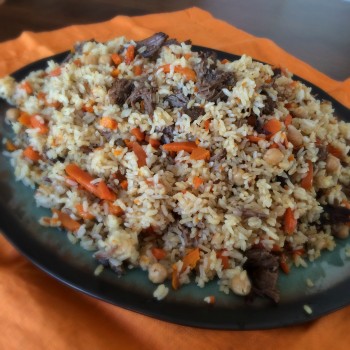The melting pot of Los Angeles is one of the best places on Earth to try ethnic foods from just about everywhere. So it’s odd that the tasty cuisine of Uzbekistan remains underrepresented in the city’s culinary landscape. But later this summer, thanks to a Kickstarter campaign by husband-and-wife owners Firuza Musaeva (an Uzbekistan native) and Dan Levy, L.A. will get it’s only all-Uzbek restaurant: Samarkand Cafe. Rico went to their home for a preview, to to learn about the cuisine, and to sample the king of pilafs.

Rico Gagliano: For the geographically-challenged: where is Uzbekistan?
Firuza Musaeva: It’s in central Asia, let’s say the south part of central Asia. We border with Afghanistan. I say Afghanistan because I think if I name other countries, they are also less-known: like Kyrgyzstan, Kazahkstan…
Rico Gagliano: Yeah, that doesn’t help us place it in the world!
Firuza Musaeva: … So, Afghanistan is the most famous country — infamous or famous, I don’t know — country that we border with. It’s quite a big country in terms of population. It’s the most populated country in central Asia.
Rico Gagliano: And, you describe the cuisine of this area as being kind of the first ‘fusion’ foods. Tell me what cuisines are incorporated into Uzbek cooking?
Dan Levy: You could say that the famous Silk Road, it went through Uzbekistan, from China to Istanbul. So all the culture from China went, at one point, through Uzbekistan. The Persians, they went through Uzbekistan. So, at the end of the day, Uzbekistan is like a fusion between Middle East, Persian and Chinese food. So you have a lot of Chinese dishes. Like dumpling becomes manti.
Rico Gagliano: The Chinese dumpling becomes, what is it called? Manti? Tell me the difference between, say, a Chinese dumpling and an Uzbek dumpling.
Firuza Musaeva: I guess it’s different herbs and the meat. We, of course, don’t use pork — mainly beef, sometimes mixed with lamb. And also we have pumpkin manti which is great, which is light but at the same time delicious.
Rico Gagliano: So, you said Persian. What is the Persian influence? Is there a dish that specifically screams Persian?
Dan Levy: Pilaf. Pilaf and samsa maybe, too. The samsa is like samosa from India. And the Persians went through India, and they left some food there, so the samosa and the samsa has the same origin.
Rico Gagliano: The Indian samosa and the Uzbek samsa both originate from the same Persian food, you’re saying?
Dan Levy: Maybe, maybe, yeah.
Rico Gagliano: And, the other thing you mentioned was pilaf, which is called ‘plov’? Is that right?
Firuza Musaeva: Plov is the Russian way. “Polow” is the Uzbek way.
Rico Gagliano: And my understanding is that this is the essential dish of Uzbek cooking.
Firuza Musaeva: Yes, that is the most famous.
Rico Gagliano: In the same way that you have pasta at every meal in Italy, do you have polow at every meal?
Firuza Musaeva: At every wedding. And I would probably be right if I say a good Uzbek family cooks pilaf once a week.
Rico Gagliano: It’s the essential wedding dish, basically? It’s like the wedding chicken of Uzbekistan?
Firuza Musaeva: Yes, yes. Big events, they don’t go without pilaf. It is the main course… let’s say the queen — excuse me, the king, sorry Polow — the king of main courses of Uzbek dishes.
Rico Gagliano: Queens and kings are equally-powerful at different places in the world, it’s fine! But you’re going to make some polow, is that right?
Firuza Musaeva: Yes. We already started cooking. So soon we’re going to serve it.
Rico Gagliano: All right. Let’s go take a look.
So, we’re standing by the stove. The polow is cooking in what looks like a giant, deep wok with no handle, and it’s been cooking for quite a while. How long does this take to make?
Firuza Musaeva: It depends, because if it’s for a lot of people, it will take you a longer time to cut. Because the main thing to cut is the carrots. It’s time-consuming to cut the carrots.
Rico Gagliano: I know — I hate cutting carrots.
Firuza Musaeva: Also, it’s very important. I mean, ideally, it’s supposed to be yellow carrots.
Rico Gagliano: I didn’t even know there were yellow carrots.
Firuza Musaeva: Yeah, and it’s so nice and so tasty. Unfortunately, here, we don’t have yellow carrots. Even if we have, they’re quite expensive. Orange carrots are also not bad, but it makes it sweeter.
Rico Gagliano: Yellow carrots are less sweet?
Firuza Musaeva: Yes. They are less sweet. I think, more juicy. But also, the carrot is the soul of pilaf.
Rico Gagliano: Really?
Firuza Musaeva: Yes, for Uzbek pilaf — I’m not claiming myself to be an expert in any other pilaf! But, you know, every family makes their own pilaf their own way, because we have… I think it is a hundred types of pilafs in Uzbekistan.
Rico Gagliano: A hundred kinds? I guess that’s not crazy to think. I mean, it’s rice with stuff in it, and you can do a lot with that. Still, that’s a lot.
Firuza Musaeva: Yes; different meats. But, mainly, it is beef and lamb.
Rico Gagliano: So, it’s still cooking on very, very low heat. How much longer?
Firuza Musaeva: We are done, actually. I have to turn it off.
Rico Gagliano: It looks lovely. Rice… chickpeas in there… I see the carrots. I don’t see the meat in there right now —
Firuza Musaeva: Because we cook it by layers.
Rico Gagliano: Okay, so you’ve got meat on the bottom layer, which I can’t see yet. And you are now ladling the rice into a larger pot, exposing the layers of carrot and meat at the bottom. Oh, man. There’s a lot of drippings at the bottom of the pan.
Firuza Musaeva: Ideally, I’m supposed to serve all this.
Rico Gagliano: All of the drippings?
Firuza Musaeva: Oil and fat and all that, you know?
Rico Gagliano: But, you’re not going to?
Firuza Musaeva: If you are adventurous enough, I can.
Rico Gagliano: You just mix it up with the rice?
Firuza Musaeva: Yes.
Rico Gagliano: Yeah, that’s fine! I love greasy rice, are you kidding me?
Now you’ve transferred all the different layers over into another, bigger pot, and you’re going to mix all that up, I guess. There’s a ton of this, too. You’re going to get some biceps mixing that up.
Firuza Musaeva: Yeah, that’s true.
Rico Gagliano: All right. Now, I’m going to be very barbaric and just take a spoonful without even transferring the food onto my own plate.
Firuza Musaeva: This is how it’s eaten in Uzbekistan.
Rico Gagliano: Just, everybody eats off the main serving plate?
Firuza Musaeva: From one plate. Even at home, we did that.
Rico Gagliano: And, here we go.
That’s delicious. It’s really soulful.
Firuza Musaeva: Told you: carrots! The soul of pilaf.
Rico Gagliano: They are very soulful carrots. The meat is just as tender as can be… Actually, Dan, I have to ask you — so, you are French, sir…
Dan Levy: Yeah, I’m French.
Rico Gagliano: …This is a tough question for you, as a Frenchman: which cuisine do you prefer?
Dan Levy: Oh my God.
Rico Gagliano: You’re a Frenchman starting an Uzbek restaurant.
Dan Levy: It’s difficult, you know?
Firuza Musaeva: Especially asking that question in front of me! Come on: We’re married, we have two children — don’t do that to him!



Pingback: Samarkand cafe was on the Radio !!! on 89.3 KPCC….. « Samarkand Cafe()